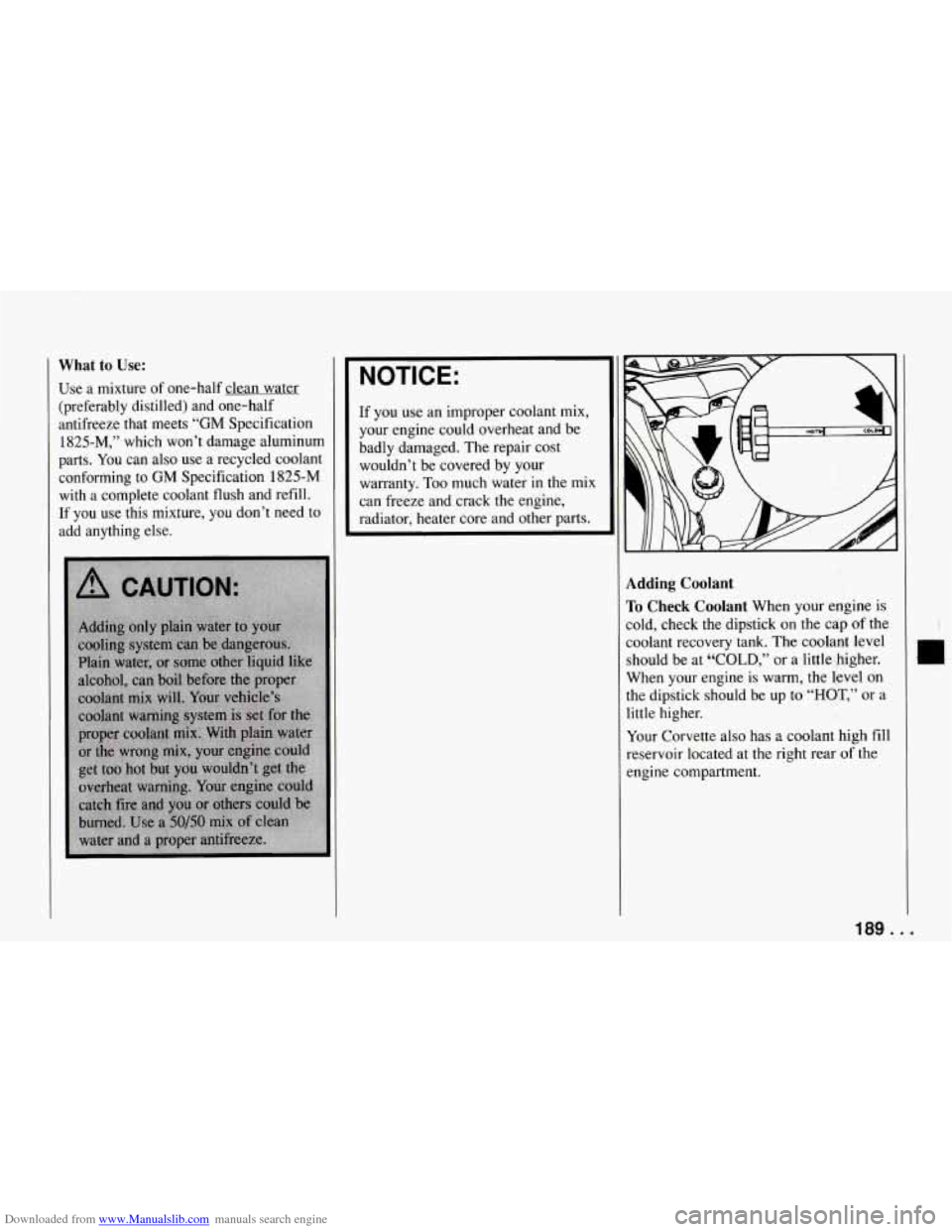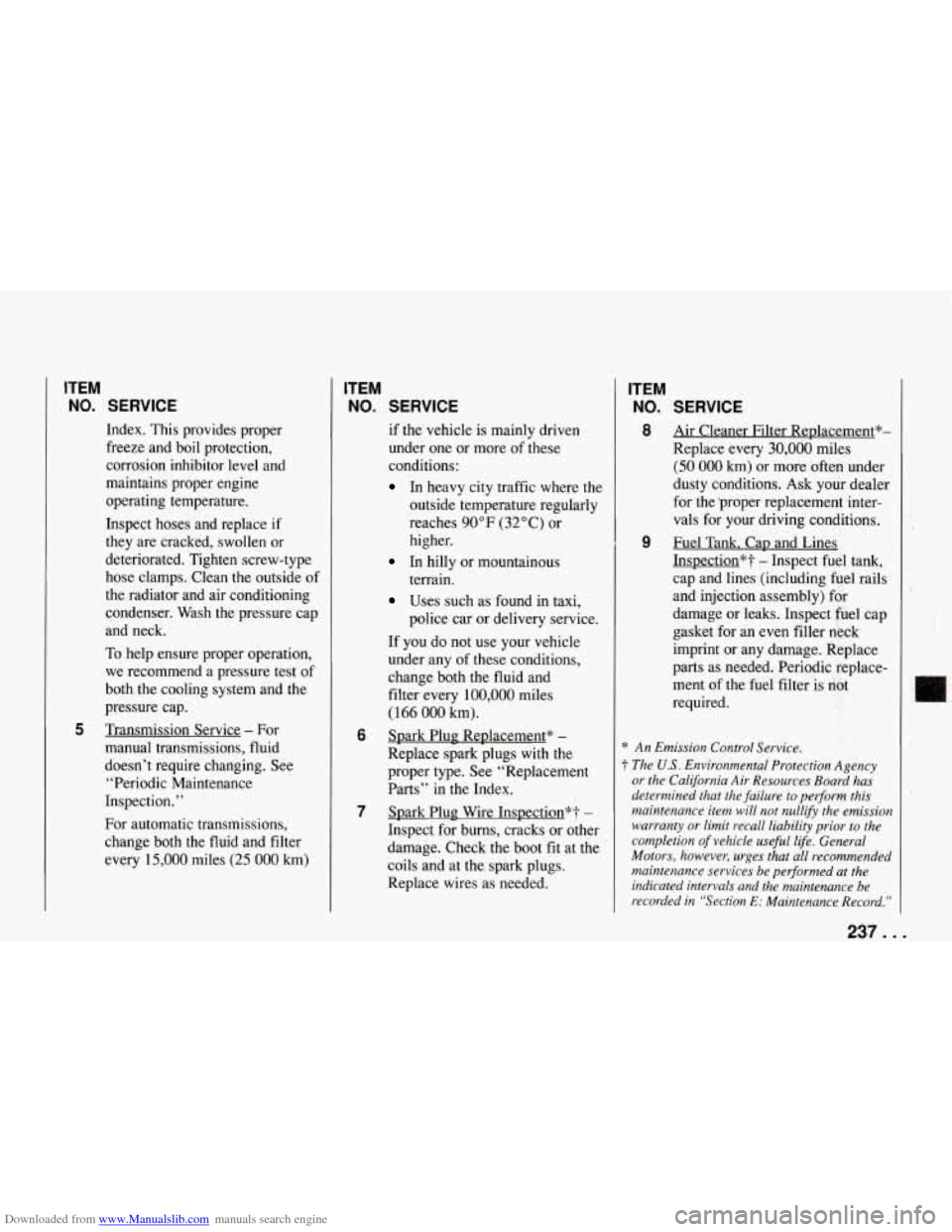Page 153 of 274
Downloaded from www.Manualslib.com manuals search engine Problems on the Road
F
Cooling System
When you decide it’s safe to lift the hood,
here’s what you’ll see on the
LT5 engine:
1. Coolant recovery tank
2. Coolant high fill reservoir with
3. Electric engine fans
pressure cap
. . -152
If
the coolant inside the coolant recovery
tank is boiling, don’t do anything else
until it cools down.
When it is cool, remove the coolant
recovery tank cap and look at the dipstick.
The coolant level should be at or above
“COLD.” If it isn’t, you may have a leak
in the radiator hoses, heater hoses,
radiator, water pump or somewhere else
in the cooling system.
I NOTICE:
I
Engine damage from running your
engine without coolant isn’t covered
by your warranty.
If there seems to be no leak, check
to see
if the electric engine fans are running.
If the engine is overheating, both fans
should be running.
If they aren’t, your
vehicle needs service.
Page 155 of 274
Downloaded from www.Manualslib.com manuals search engine Problems on the Road
How to Add Coolant to the Coolant
High
Fill Reservoir - LT1 Only
NOTICE:
I
The LT1 engine (Code P) has a
specific coolant high fill reservoir
fill procedure. Failure to follow this
procedure could cause your engine to
overheat and be severely damaged.
1. You can remove the coolant high fill
reservoir pressure cap when the
cooling system, including the coolant
high fill reservoir pressure cap and
upper radiator hose,
is no longer hot. Turn the pressure cap slowly to
the
left until
it first stops. (Don't press
down while turning the pressure cap.)
If
you hear a hiss, wait for that to stop.
A hiss means there is still some
pressure left.
. . .I54
Page 158 of 274
Downloaded from www.Manualslib.com manuals search engine How to Add Coolant to the Coolant
High Fill Reservoir
(5.7L LT5 (Code J)
Engine)
1. You can remove the coolant high fill
reservoir pressure cap when the
cooling system, including the coolant
high fill reservoir pressure cap
and
upper radiator hose, is no longer hot.
Turn the pressure cap slowly to the
left until it first stops. (Don’t press
down while turning the pressure cap.)
If you hear a hiss, wait for that to stop.
A hiss means there is still some
pressure left.
2. Then keep turning the pressure cap,
but now push down as you turn it.
Remove the pressure cap. 3. Fill the coolant high fill reservoir with
the proper mix, up to the base of the
filler neck.
157 ...
Page 159 of 274
Downloaded from www.Manualslib.com manuals search engine Problems on the Road
4. Then fill the coolant recovery tank to
the “HOT” mark
on the dipstick.
5. Put the cap back on the coolant
recovery tank, but leave
the coolant
high fill reservoir pressure cap
off.
6. Start the engine and let it run until
you can feel the upper radiator hose
getting hot. Watch out for the engine
fans.
7. By this time the coolant level inside
the coolant high fill reservoir filler
neck may be lower. If the level is
lower, add more of the proper
mix
through the filler neck until the level
reaches the base of the filler neck.
. . .158
Page 190 of 274

Downloaded from www.Manualslib.com manuals search engine What to Use:
Use a mixture of one-half clean water
(preferably distilled) and one-half
antifreeze that meets “GM Specification
1825-M,” which won’t damage aluminum
parts.
You can also use a recycled coolant
conforming to GM Specification 1825-M
with a complete coolant flush and refill.
If you use this mixture, you don’t need to
add anything else.
NOTICE:
If you use an improper coolant mix,
your engine could overheat and be
badly damaged. The repair cost wouldn’t be covered by your
warranty.
Too much water in the mix
can freeze and crack the engine,
radiator, heater core and other parts.
Adding Coolant
I’o Check Coolant When your engine is
;old, check the dipstick on the cap of the
;oolant recovery tank. The coolant level
should be at “COLD,” or a little higher.
When your engine is warm, the level on
the dipstick should be up to “HOT,” or a
little higher.
Your Corvette also has a coolant high fill
reservoir located at the right rear of the
engine compartment.
189 ...
Page 193 of 274
Downloaded from www.Manualslib.com manuals search engine Service and Appearance Care
NOTICE:
When adding power steering ,fluid or
making a complete fluid change,
always use the proper fluid. Failure
to use the proper fluid can cause
leaks and damage hoses and seals.
L
Windshield Washer Fluid
To Add:
Open the cap labeled “WASHER FLUID
ONLY.” Add washer fluid until the bottle
is full.
NOTICE:
0 When using concentrated washer
fluid, follow the manufacturer’s
instructions for adding water.
Don’t mix water with
ready-to-use washer fluid. Water
can cause the solution to freeze
and damage your washer fluid
tank and other parts of the washer
system. Also, water doesn’t clean
as well as washer fluid.
0 Fill your washer fluid tank only
3/4 full when it’s very cold. This
allows for expansion, which could
damage the tank if it is completely
full.
0 Don’t use radiator antifreeze in
your windshield washer. It can
damage your washer system and
paint.
. . .I92
Page 238 of 274

Downloaded from www.Manualslib.com manuals search engine ITEM
NO. SERVICE
Index. This provides proper
freeze and boil protection,
corrosion inhibitor level and
maintains proper engine
operating temperature.
Inspect hoses and replace if
they are cracked, swollen or
deteriorated. Tighten screw-type
hose clamps. Clean the outside of
the radiator and air conditioning
condenser. Wash the pressure cap
and neck.
To help ensure proper operation,
we recommend a pressure test of
both the cooling system and the
pressure cap.
5 Transmission Service - For
manual transmissions, fluid
doesn’t require changing. See
“Periodic Maintenance
Inspection.”
For automatic transmissions,
change both the fluid and filter
every
15,000 miles (25 000 km)
ITEM
NO. SERVICE
if the vehicle is mainly driven
under one or more of these
conditions:
In heavy city traffic where the
outside temperature regularly
reaches
90 OF (32 O C) or
higher.
In hilly or mountainous
terrain.
Uses such as found in taxi,
police car or delivery service.
If you do not use your vehicle
under any of these conditions,
change both
the fluid and
filter every
100,000 miles
(1 66 000 km).
Replace spark plugs with the
proper type. See “Replacement
Parts” in the Index.
6 Spark Plug Replacement* -
7 Spark Plug Wire Inspection*? -
Inspect for burns, cracks or other
damage. Check the boot fit at the
coils and at the spark plugs.
Replace wires as needed.
ITEM
NO. SERVICE
8 Air Cleaner Filter Replacement*-
Replace every
30,000 miles
(50 000 km) or more often under
dusty conditions. Ask your dealer
for the ’proper replacement inter-
vals for your driving conditions.
Inspection*?
- Inspect fuel tank,
cap and lines (including fuel rails
and injection assembly) for
damage or leaks. Inspect fuel cap
gasket for an even filler neck
imprint or any damage. Replace
parts as needed. Periodic replace-
ment of the fuel filter is not
required.
9 Fuel Tank. Cap and Lines
* An Emission Control Service.
t The U.S. Environmental Protection Agency
or the California Air Resources Board has
determined that the failure to perform this
maintenance item will not nullify the emission
warranty or limit recall liability prior to the
completion
of vehicle useful life. General
Motors, however, urges that all recommended
maintenance services be performed at the
indicated intervals and the maintenance be
recorded in “Section
E: Maintenance Record.”
I -I
237. . .